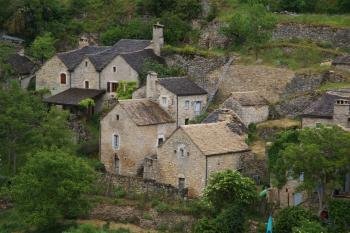
The agro-pastoral landscape of the Causses and Cevennes spreads over a wide area and consists of high plains (Causse Méjan, Causse Noir, Causse du Larzac), mountain ranges (Cevennes, Mont Lozère, Mont Aigoual) and narrow gorges (Gorges du Tarn, Gorges de la Jonte). Not easy to figure out which sites are worthwhile to get the best impression of both the natural heritage and the rural architecture. Thus, I studied extensively the nomination dossier, identified some places that seemed to be the most interesting, and finally planned our route for the two days we had scheduled for this WHS.
We started early in the morning in Le Puy-en-Velay and after 1.5 hours we entered the core zone at the northern slopes of the Mont Lozère massif. The narrow road (D20) goes close past the highest summit of the massif, the Sommet de Finiels, to Le Pont-de-Montvert. We had a first stop near the summit for a short hike. Actually, it is a high plateau rather than a steep peak, a sparse and stony landscape with conifers and yellow broom. Apart from us there was nobody around and the morning fog made a bit of a spooky atmosphere. Le Pont-de-Montvert is one of the larger villages in the area. We bought some cheese and the obligatory baguette to get through the day, and continued our trip heading towards the Gorges du Tarn. We took the narrow road D35 and came past lonely barnyards and through small hamlets, and saw some typical examples of rural architecture (eg the church in Fraissinet-de-Lozère or the bell tower in the village La Fage). The houses are made of granite stones, low and compact to withstand the harsh weather, but they are of a rough beauty. However, many of the houses and farms seemed to be uninhabited.
In Ispagnac begins the narrowest and most beautiful part of the Gorges du Tarn. The road leads along the western river bank through some lovely villages like Sainte-Enimie (one of 'Les Plus Beaux Villages de France'), Sainte-Chély-du-Tarn, or La Malène. Here, the buildings are made of limestone, but similar to the granite architecture at Mont Lozère also plain and massive, in harmony with the nature around. The most picturesque villages are on the eastern bank: Castelbouc and Hauterives (photo), the small houses seem to glue on the steep slope. Hauterives can only be reached by foot, there is no street. The gorge is a popular tourist destination, in particular with canoeists. We learned that many of the houses have been restored and are used as summer and weekend cottages. In Vignes, a winding road branches off towards Point Sublime, a viewing point with a great panoramic view of the Gorges du Tarn, the short detour is worthwhile. The gorge ends at Le Rozier. When we arrived there, it was early enough to visit the Chaos de Montpellier-le-Vieux. Like Els, we took the red walk and enjoyed our hike through the rock formations with curious names like 'Crocodile', 'Door of Mycène', or 'Large Sphinx'.
We stayed overnight near Millau, where we also visited the Millau Viaduct. For the next day, we actually had planned a longer hike in the Causse Méjan (a hike in one of these austere and almost deserted Causses must be very contemplative). But the weather was cloudy and windy, so we skipped our hike in favour of a visit in Roquefort. We took a guided tour at the Roquefort Sociète, the largest cheese manufacturer in Roquefort. The tour (1 hour) started with an animated model explaining the geology that formed the cave. At the next stop we saw a 'fleurine' - one of the narrow fissures that extends through the entire rock and allows air circulation, a unique feature important for the maturation of the Roquefort. Then we watched a film on the history and the process of cheese making, followed by a rather dispensable sound-and-light-show. Too much of that multi-media stuff for my taste. The caves themselves were rather disappointing. We expected a high vaulted cellar, similar to an old wine cellar. But the cave was divided into various levels by timber floors, the levels were not much higher than a normal room. Behind acrylic glass we saw rows of cheese wheels stored on wooden shelves. The guide explained the different steps of Roquefort production and demonstrated how a cheese wheel is wrapped in a thin sheet of pewter, obviously also an important step. The tour was in French, but there are explanatory panels in various languages. Finally, we tasted three different types of Roquefort. The tour was not bad, but I don't think that Els has missed a lot. However, the caves could be more interesting at one of the smaller manufacturers.
After that we had short stops at the Templar sites Viala du Pas de Jaux, Sainte-Eulalie-de-Cernon, and La Couvertoirade. The latter is the most interesting, like a smaller copy of Carcassonne, but not a must-see. Finally, we had a last stop at the Cirque de Navacelles, also mentioned in Els' review above.
All in all, an interesting and probably underrated WHS, with worth seeing natural sites and intact rural architecture. We saw the pasture landscape, we saw barns for sheep, drinking troughs (lavogne) for sheep, and a cistern, we tasted sheep's cheese, and we met a woman selling sheep's wool, but in two days we never saw a sheep!
More on
Comments
No comments yet.
